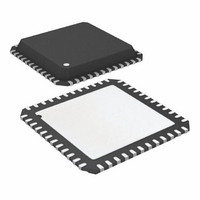ATA6613P-PLPW Atmel, ATA6613P-PLPW Datasheet - Page 239

ATA6613P-PLPW
Manufacturer Part Number
ATA6613P-PLPW
Description
MCU W/LIN TXRX REG WTCHDG 48-QFN
Manufacturer
Atmel
Series
AVR® ATA66 LIN-SBCr
Datasheet
1.ATA6612-EK.pdf
(364 pages)
Specifications of ATA6613P-PLPW
Core Processor
AVR
Core Size
8-Bit
Speed
16MHz
Connectivity
I²C, LIN, SPI, UART/USART
Peripherals
Brown-out Detect/Reset, POR, PWM, WDT
Number Of I /o
23
Program Memory Size
16KB (16K x 8)
Program Memory Type
FLASH
Eeprom Size
512 x 8
Ram Size
1K x 8
Voltage - Supply (vcc/vdd)
2.7 V ~ 5.5 V
Data Converters
A/D 8x10b
Oscillator Type
Internal
Operating Temperature
-40°C ~ 125°C
Package / Case
48-QFN Exposed Pad
Processor Series
ATA6x
Core
AVR8
Data Bus Width
8 bit
Data Ram Size
1 KB
Interface Type
SPI, TWI, USART
Maximum Clock Frequency
16 MHz
Number Of Programmable I/os
23
Number Of Timers
3
Maximum Operating Temperature
+ 125 C
Mounting Style
SMD/SMT
Minimum Operating Temperature
- 40 C
On-chip Adc
10 bit, 8 Channel
Lead Free Status / RoHS Status
Lead free / RoHS Compliant
- Current page: 239 of 364
- Download datasheet (7Mb)
9111H–AUTO–01/11
• Bit 6 – TWEA: TWI Enable Acknowledge Bit
• Bit 5 – TWSTA: TWI START Condition Bit
• Bit 4 – TWSTO: TWI STOP Condition Bit
• Bit 3 – TWWC: TWI Write Collision Flag
• Bit 2 – TWEN: TWI Enable Bit
• Bit 1 – Res: Reserved Bit
• Bit 0 – TWIE: TWI Interrupt Enable
While the TWINT Flag is set, the SCL low period is stretched. The TWINT Flag must be
cleared by software by writing a logic one to it. Note that this flag is not automatically
cleared by hardware when executing the interrupt routine. Also note that clearing this flag
starts the operation of the TWI, so all accesses to the TWI Address Register (TWAR), TWI
Status Register (TWSR), and TWI Data Register (TWDR) must be complete before clear-
ing this flag.
The TWEA bit controls the generation of the acknowledge pulse. If the TWEA bit is written
to one, the ACK pulse is generated on the TWI bus if the following conditions are met:
The device’s own slave address has been received.
A general call has been received, while the TWGCE bit in the TWAR is set.
A data byte has been received in Master Receiver or Slave Receiver mode.
By writing the TWEA bit to zero, the device can be virtually disconnected from the 2-wire
Serial Bus temporarily. Address recognition can then be resumed by writing the TWEA bit
to one again.
The application writes the TWSTA bit to one when it desires to become a Master on the
2-wire Serial Bus. The TWI hardware checks if the bus is available, and generates a
START condition on the bus if it is free. However, if the bus is not free, the TWI waits until
a STOP condition is detected, and then generates a new START condition to claim the
bus Master status. TWSTA must be cleared by software when the START condition has
been transmitted.
Writing the TWSTO bit to one in Master mode will generate a STOP condition on the
2-wire Serial Bus. When the STOP condition is executed on the bus, the TWSTO bit is
cleared automatically. In Slave mode, setting the TWSTO bit can be used to recover from
an error condition. This will not generate a STOP condition, but the TWI returns to a
well-defined unaddressed Slave mode and releases the SCL and SDA lines to a high
impedance state.
The TWWC bit is set when attempting to write to the TWI Data Register – TWDR when
TWINT is low. This flag is cleared by writing the TWDR Register when TWINT is high.
The TWEN bit enables TWI operation and activates the TWI interface. When TWEN is
written to one, the TWI takes control over the I/O pins connected to the SCL and SDA
pins, enabling the slew-rate limiters and spike filters. If this bit is written to zero, the TWI is
switched off and all TWI transmissions are terminated, regardless of any ongoing
operation.
This bit is a reserved bit and will always read as zero.
When this bit is written to one, and the I-bit in SREG is set, the TWI interrupt request will
be activated for as long as the TWINT Flag is high.
Atmel ATA6612/ATA6613
239
Related parts for ATA6613P-PLPW
Image
Part Number
Description
Manufacturer
Datasheet
Request
R

Part Number:
Description:
MCU W/LIN TXRX REG WTCHDG 48-QFN
Manufacturer:
Atmel
Datasheet:

Part Number:
Description:
Ata6613
Manufacturer:
ATMEL Corporation
Datasheet:

Part Number:
Description:
BOARD DEMO LIN-MCM FOR ATA6613
Manufacturer:
Atmel
Datasheet:

Part Number:
Description:
DEV KIT FOR AVR/AVR32
Manufacturer:
Atmel
Datasheet:

Part Number:
Description:
INTERVAL AND WIPE/WASH WIPER CONTROL IC WITH DELAY
Manufacturer:
ATMEL Corporation
Datasheet:

Part Number:
Description:
Low-Voltage Voice-Switched IC for Hands-Free Operation
Manufacturer:
ATMEL Corporation
Datasheet:

Part Number:
Description:
MONOLITHIC INTEGRATED FEATUREPHONE CIRCUIT
Manufacturer:
ATMEL Corporation
Datasheet:

Part Number:
Description:
AM-FM Receiver IC U4255BM-M
Manufacturer:
ATMEL Corporation
Datasheet:

Part Number:
Description:
Monolithic Integrated Feature Phone Circuit
Manufacturer:
ATMEL Corporation
Datasheet:

Part Number:
Description:
Multistandard Video-IF and Quasi Parallel Sound Processing
Manufacturer:
ATMEL Corporation
Datasheet:

Part Number:
Description:
High-performance EE PLD
Manufacturer:
ATMEL Corporation
Datasheet:

Part Number:
Description:
8-bit Flash Microcontroller
Manufacturer:
ATMEL Corporation
Datasheet:










